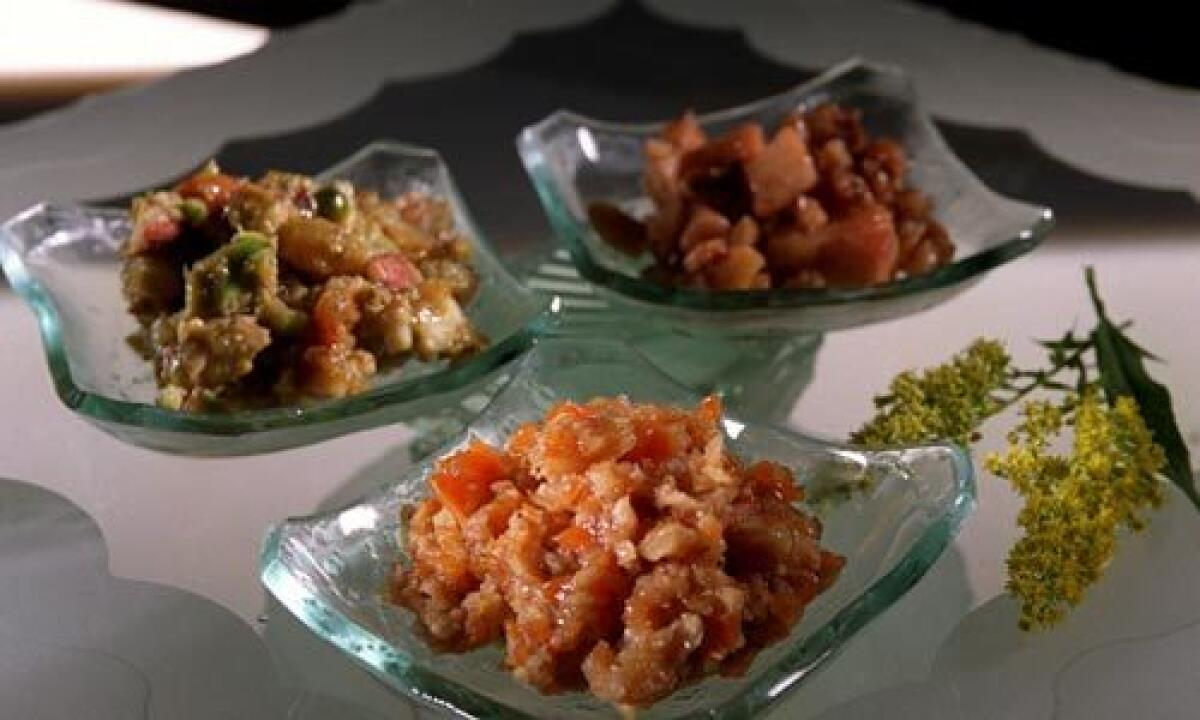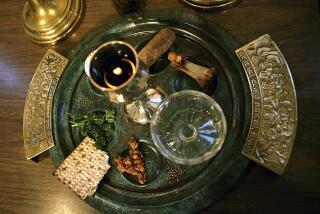<i>Charosets</i> of the World

- Share via
For as long as I can remember, Passover has been the most important holiday in our home, and everyone looks forward to the Seder. Family and friends, often as many as 30, attend the event, and I am constantly looking for new and different ideas to enliven their Passover experience. Passover begins at sundown today.
Before the meal, the story of the exodus from Egypt is retold, and everyone participates, from the oldest to the very young. The Seder plate of foods that symbolize the events that took place long ago is prominently displayed on the table. One of these foods is charoset, a fruit, nut and wine mixture that represents the mortar used by the Jews when they were slaves in Egypt.
Charoset ingredients vary according to the areas where Jews traveled and depend on which products were available. The mixture from Eastern Europe was usually apples, walnuts, cinnamon and sweet wine. The Sephardic recipes differ depending on the country. The Yemenite Jews, for example, make charoset with dates, dried figs, coriander and cayenne pepper, making for a spicy mixture, typical of Yemen’s cuisine.
At my Seder table, I try to have representatives of many of these different charosets. A label is attached to each plate to identify the country it represents. This makes for lots of conversation, and our guests discuss where their ancestors came from and which fruits, nuts and spices were used in their families.
In keeping with the concept of using local products, I decided to create a special California-style charoset and have given it to our children. I hope that they will include it as part of their family Seder. The recipe, combining ingredients typical of California, consists of avocados, prunes, almonds, orange juice and raisins. Perhaps this idea will inspire you to create your own charoset recipe.
This year, I plan to surprise my family with several new recipes that combine charoset with some of the typical foods we normally eat during the eight-day holiday.
One of these is a chicken “sausage” stuffed with a Greek charoset of dates, raisins and ginger. It can be a welcome change from the roasted chicken that is usually offered as a main course. In this recipe, I wrap the boned chicken breasts with plastic wrap to resemble a sausage and poach them for 15 minutes. The liquid trapped inside the wrap develops its own flavors and, when unwrapped, becomes a wonderful sauce for the chicken.
Lamb is one of the traditional Passover foods, and I have added a Middle Eastern Sephardic charoset mixture to my lamb burgers. It adds an unusual flavor and sweetness to the lamb and keeps it tender and juicy. Mashed potatoes and spring asparagus are a perfect accompaniment.
To finish the Seder dinner, one Passover dessert will be a homemade coffee cake filled and topped with Eastern European charoset. The chopped apple-nut mixture brings a unique taste and adds crunch to the cake.
More to Read
Eat your way across L.A.
Get our weekly Tasting Notes newsletter for reviews, news and more.
You may occasionally receive promotional content from the Los Angeles Times.










